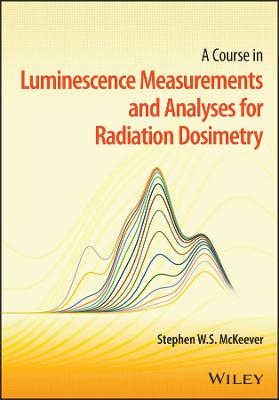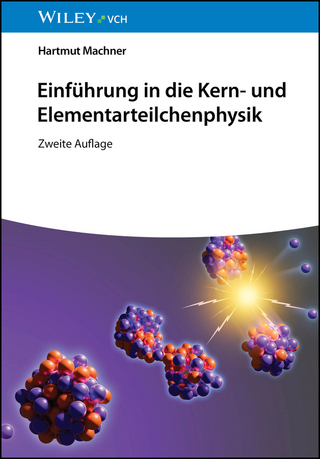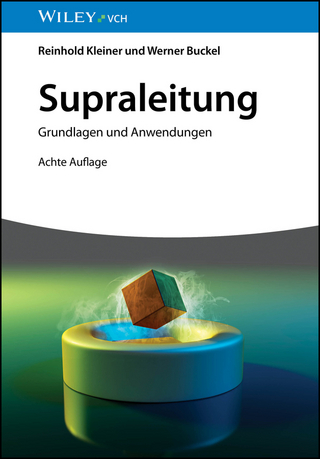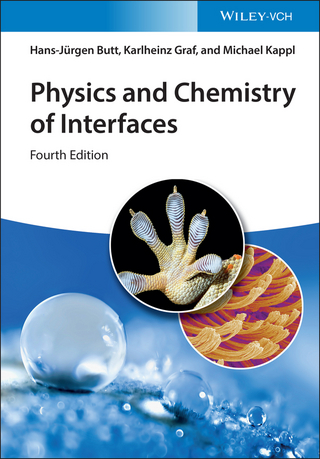
A Course in Luminescence Measurements and Analyses for Radiation Dosimetry
John Wiley & Sons Inc (Verlag)
978-1-119-64689-1 (ISBN)
In A Course in Luminescence Measurements and Analyses for Radiation Dosimetry, expert researcher Stephen McKeever delivers a holistic and comprehensive exploration of the three main luminescence techniques used in radiation dosimetry: thermoluminescence, optically stimulated luminescence, and radiophotoluminescence. The author demonstrates how the three techniques are related to one another and how they compare to each other.
Throughout, the author’s focus is on pedagogy, including state-of-the-art research only where it is relevant to demonstrate a key principle or where it reveals a critical insight into physical mechanisms. The primary purpose of the book is to teach beginning researchers about the three aforementioned techniques, their similarities and distinctions, and their applications.
A Course in Luminescence Measurements and Analyses for Radiation Dosimetry offers access to a companion website that includes original data sets and problems to be solved by the reader. The book also includes:
A thorough introduction to the field of luminescence applications in radiation dosimetry, including a history of the subject.
Comprehensive explorations of introductory models and kinetics, including the concepts of thermoluminescence, optically stimulated luminescence, and radiophotoluminescence.
Practical discussions of luminescence curve shapes, including the determination of trapping parameters from experimental thermoluminescence and optically stimulated luminescence data.
In-depth examinations of dose-response functions, superlinearity, supralinearity, and sublinearity, as well as the causes of non-linearity.
Detailed examples with well-known materials.
A Course in Luminescence Measurements and Analyses for Radiation Dosimetry is an invaluable guide for undergraduate and graduate students in the field of radiation dosimetry, as well as faculty and professionals in the field.
Stephen W.S. McKeever is an Emeritus Regents Professor in the Department of Physics at Oklahoma State University in the United States. He has published over 200 peer-reviewed papers in the field of luminescence measurements for radiation dosimetry.
Preface xiii
Acknowledgments xvii
Disclaimer xviii
About the Companion Website xix
Part I Theory, Models, and Simulations 1
1 Introduction 3
1.1 How Did We Get Here? 3
1.2 Introductory Concepts for TL, OSL, and RPL 7
1.2.1 Equilibrium and Metastable States 7
1.2.2 Fermi-Dirac Statistics 8
1.2.3 Related Processes 10
1.3 Brief Overview of Modern Applications in Radiation Dosimetry 12
1.3.1 Personal Dosimetry 13
1.3.2 Medical Dosimetry 14
1.3.3 Space Dosimetry 15
1.3.4 Retrospective Dosimetry 16
1.3.5 Environmental Dosimetry 18
1.4 Bibliography of Luminescence Dosimetry Applications 18
2 Defects and Their Relation to Luminescence 19
2.1 Defects in Solids 19
2.1.1 Point Defects 19
2.1.2 Extended Defects 23
2.1.3 Non-Crystalline Materials 23
2.2 Trapping, Detrapping, and Recombination Processes 24
2.2.1 Excitation Probabilities 24
2.2.1.1 Thermal Excitation 24
2.2.1.2 Optical Excitation 28
2.2.2 Trapping and Recombination Processes 31
3 TL and OSL: Models and Kinetics 35
3.1 Rate Equations: OTOR Model 35
3.2 Analytical Solutions: TL Equations 38
3.2.1 First-Order Kinetics 38
3.2.2 Second-Order and General-Order Kinetics 41
3.2.3 Mixed-Order Kinetics 46
3.3 Analytical Solutions: OSL Equations 49
3.3.1 First-Order Kinetics 51
3.3.1.1 Expressions for CW-OSL 51
3.3.1.2 Expressions for LM-OSL 51
3.3.1.3 Expressions for POSL 52
3.3.1.4 Expressions for VE-OSL 54
3.3.2 Non-First-Order Kinetics 57
3.4 More Complex Models: Interactive Kinetics 57
3.4.1 Thermoluminescence 57
3.4.2 Optically Stimulated Luminescence 65
3.5 Trap Distributions 68
3.6 Quasi-Equilibrium (QE) 75
3.6.1 Numerical Solutions: No QE Assumption 75
3.6.2 P and Q Analysis 75
3.6.3 Analytical Solutions: No QE Assumption 78
3.7 Thermal and Optical Effects 81
3.7.1 Thermal Quenching 82
3.7.1.1 Mott-Seitz Model 82
3.7.1.2 Schön-Klasens Model 85
3.7.1.3 Tests for Thermal Quenching 87
3.7.2 Thermal Effects on OSL 89
3.7.2.1 Effects of Shallow Traps 89
3.7.2.2 Effects of Deep Traps: Thermally Transferred OSL (TT-OSL) 91
3.7.3 More Temperature Effects for TL and OSL 92
3.7.3.1 Phonon-coupling 93
3.7.3.2 Shallow Traps 93
3.7.3.3 Sub-Conduction Band Excitation 93
3.7.3.4 Random Local Potential Fluctuations (RLPF) 95
3.7.4 Optical Effects on TL 96
3.7.4.1 Bleaching 96
3.7.4.2 Phototransferred TL (PTTL) 101
3.8 Tunneling, Localized and Semi-Localized Transitions 104
3.8.1 Tunneling 106
3.8.1.1 General Considerations 106
3.8.1.2 Ground-State Tunneling 107
3.8.1.3 Excited-State Tunneling 110
3.8.1.4 Decay during Irradiation 113
3.8.1.5 Effect of Tunneling on TL and OSL 113
3.8.2 Localized and Semi-localized Transition Models 115
3.8.2.1 Localized Transition Model 115
3.8.2.2 Semi-Localized Transition Model 116
3.8.2.3 Semi-Localized Transitions and the TL Glow Curve 122
3.9 Master Equations 123
4 RPL: Models and Kinetics 125
4.1 Radiophotoluminescence and Its Differences with TL and OSL 125
4.2 Background Considerations 125
4.3 Buildup Kinetics 128
4.3.1 Electronic Processes 128
4.3.2 Ionic Processes 130
4.3.3 More on Buildup Processes 134
4.3.3.1 After Irradiation 134
4.3.3.2 During Irradiation 135
4.3.3.3 Temperature Dependence 135
5 Analysis of TL and OSL Curves 139
5.1 Analysis of TL Glow Curves 139
5.2 Analytical Methods for TL 140
5.2.1 Partial-Peak Methods 140
5.2.1.1 A Single TL Peak with a Discrete Value for E t 140
5.2.1.2 Multiple Overlapping Peaks, and Trap Energy Distributions143 5.2.2 Whole-Peak Methods 150
5.2.3 Peak-Shape Methods 153
5.2.4 Peak-Position Methods 155
5.2.5 Peak-Fitting Methods 159
5.2.5.1 Principles 159
5.2.5.2 Peak Resolution 162
5.2.5.3 CGCD Using More-Than-One Heating Rate 163
5.2.5.4 Continuous Trap Distributions 166
5.2.6 Calculation of s169 5.2.7 Potential Distortions to TL Glow Curves 169
5.2.7.1 Thermal Contact 170
5.2.7.2 Thermal Quenching 171
5.2.7.3 Emission Spectra 171
5.2.7.4 Self-Absorption 175
5.2.8 Summary of Steps to Take using TL Curve Fitting 176
5.2.9 Isothermal Analysis 177
5.3 Analytical Methods for OSL 180
5.3.1 Curve-Shape Methods 180
5.3.1.1 Cw-osl 180
5.3.1.2 Lm-osl 181
5.3.2 Variable Stimulation Rate Methods: LM-OSL 181
5.3.3 Curve-Fitting Methods 184
5.3.3.1 The Curve Overlap Problem 184
5.3.3.2 Simultaneous Fitting of LM-OSL Peaks Generated by Varying the Stimulation Rate 186
5.3.4 How Can the Number of Traps Contributing to OSL Be Determined? 187
5.3.4.1 t max -t stop Analysis 187
5.3.4.2 Comparison with TL 188
5.3.5 Variation with Stimulation Wavelength 188
5.3.6 Trap Distributions 189
5.3.7 Emission Wavelength 192
5.3.8 Summary of Steps to Take using OSL Curve Fitting 193
5.3.9 OSL due to Optically Assisted Tunneling 193
5.3.10 Ve-osl 195
6 Dependence on Dose 197
6.1 TL, OSL, or RPL versus Dose 197
6.2 Dependence on Dose 197
6.2.1 OTOR Model 197
6.2.1.1 Dose-Response Relationships: Linear, Supralinear, Superlinear, and Sublinear 199
6.2.2 Interactive Models: Competition effects 203
6.2.2.1 Competition during Irradiation 203
6.2.2.2 Competition during Trap Emptying 204
6.2.3 Spatial Effects 208
6.2.4 Sensitivity and Sensitization 212
6.2.5 High Dose Effects 213
6.2.5.1 Loss of Sensitivity 213
6.2.5.2 TL and OSL Changes in Shape 215
6.2.6 Charged Particles, Tracks, and Track Interaction 216
6.2.6.1 Dose and Fluence Dependence: Low Fluence 218
6.2.6.2 High Fluence: Track Interaction 220
6.2.7 Rpl 225
6.2.7.1 Buildup during Irradiation: A Special Kind of Supralinearity 225
6.2.7.2 Buildup after Irradiation: Linear Response to Dose 227
Part II Experimental Examples: Luminescence Dosimetry Materials 229
7 Thermoluminescence 231
7.1 Introduction 231
7.2 Lithium Fluoride 232
7.2.1 LiF:Mg,Ti 232
7.2.1.1 Structure and Defects 232
7.2.1.2 TL Glow Curves 233
7.2.1.3 TL Emission Spectra 238
7.2.1.4 TL Glow-Curve Analysis 239
7.2.1.5 Changes to the Glow-Curve Shape with Dose and Ionization Density 241
7.2.1.6 Competition 248
7.2.1.7 Photon Dose-Response Characteristics 250
7.2.1.8 Charged-Particle Dose-Response Characteristics 252
7.2.2 LiF:MCP 254
7.2.2.1 Structure and Defects 254
7.2.2.2 TL Glow Curves 255
7.2.2.3 TL Emission Spectra 256
7.2.2.4 TL Glow-Curve Analysis 258
7.2.2.5 Changes to the Glow-Curve Shape with Dose and Ionization Density 259
7.2.2.6 Photon Dose-Response Characteristics 261
7.2.2.7 Charged-Particle Dose-Response Characteristics 262
7.2.3 Approximately Right; Precisely Wrong 263
8 Optically Stimulated Luminescence 267
8.1 Introduction 267
8.2 Aluminum Oxide 268
8.2.1 Al2O3 :C 268
8.2.1.1 Structure and Defects 268
8.2.1.2 OSL Curves 269
8.2.1.3 Emission and Excitation Spectra 270
8.2.1.4 Temperature Dependence 277
8.2.1.5 Photon Dose-Response Characteristics 277
8.2.1.6 Charged-Particle Dose-Response Characteristics 280
8.2.2 A Final Observation 285
9 Radiophotoluminescence 287
9.1 Introduction 287
9.2 Phosphate Glass 287
9.2.1 Ag-doped Phosphate Glass 287
9.2.1.1 Formulation, Growth, and RPL Centers 287
9.2.1.2 Emission and Excitation Spectra: RPL Decay Curves and Signal Measurement 290
9.2.1.3 Buildup Curves: Temperature Dependence; UV Reversal 294
9.2.1.4 Photon Dose-Response Characteristics 298
9.2.1.5 Charged-Particle Dose-Response Characteristics 302
9.2.2 Final Remarks Concerning RPL from Ag-doped Phosphate Glass 305
9.3 Fluorescent Nuclear Track Detectors 305
9.3.1 Al2O3 :C,Mg 305
9.3.1.1 Introduction 305
9.3.1.2 RPL in Al2O3 :C,Mg 305
9.3.1.3 FNTD Imaging of Charged-Particle Tracks 307
9.3.1.4 FNTD for Neutron Detection 310
9.3.2 LiF 312
9.3.2.1 RPL in LiF 312
9.3.2.2 Fntd 313
9.3.3 Alkali Phosphate Glass 315
9.3.3.1 Fntd 315
10 Some Examples of More Complex TL, OSL, and RPL Phenomena: The Aluminosilicates 317
10.1 Introduction 317
10.2 Feldspar 318
10.2.1 Structure and Defects 318
10.2.2 Energy Levels and Density of States 319
10.2.3 Emission Spectra 321
10.2.4 OSL Phenomena 321
10.2.4.1 Band Diagram 321
10.2.4.2 OSL Excitation Spectra 322
10.2.4.3 OSL Curve Description 324
10.2.5 TL Phenomena 330
10.2.5.1 Glow-Curve Description 330
10.2.5.2 TL Analysis 332
10.2.6 RPL Phenomena 335
10.2.6.1 RPL Emission and Excitation Spectra 335
10.2.6.2 RPL Temperature Dependence 336
10.2.7 What Can Be Concluded? 337
10.3 Aluminosilicate Glass 338
10.3.1 Structure and Composition 339
10.3.2 OSL Phenomena 340
10.3.2.1 OSL Curve Description 340
10.3.2.2 OSL Excitation Spectrum 342
10.3.2.3 OSL Fading 344
10.3.2.4 Potential Uses in Radiation Dosimetry 345
10.3.3 TL Phenomena 346
10.3.3.1 Glow-Curve Description 346
10.3.3.2 TL Emission Spectrum 349
10.3.3.3 TL Analysis 349
10.3.3.4 TL Fading 351
10.3.3.5 Potential Uses in Radiation Dosimetry 352
10.4 Final Remarks 352
11 Concluding Remarks: The Possibilities for Imperfection Engineering 355
11.1 The Importance of Defects 355
11.1.1 The Ideal Luminescence Dosimeter 355
11.1.2 How to Detect Defect Clustering and Tunneling 358
11.1.2.1 E t and s Analysis 358
11.1.2.2 TL and OSL Curve Shapes 358
11.1.2.3 Fading 359
11.1.2.4 Spectral Measurements 359
11.2 The Prospects for “Designer” TLDs, OSLDs, and RPLDs 360
References 361
Index 381
| Erscheinungsdatum | 10.06.2022 |
|---|---|
| Verlagsort | New York |
| Sprache | englisch |
| Maße | 170 x 244 mm |
| Gewicht | 1049 g |
| Themenwelt | Naturwissenschaften ► Chemie |
| Naturwissenschaften ► Physik / Astronomie ► Atom- / Kern- / Molekularphysik | |
| Technik ► Maschinenbau | |
| ISBN-10 | 1-119-64689-8 / 1119646898 |
| ISBN-13 | 978-1-119-64689-1 / 9781119646891 |
| Zustand | Neuware |
| Informationen gemäß Produktsicherheitsverordnung (GPSR) | |
| Haben Sie eine Frage zum Produkt? |
aus dem Bereich


